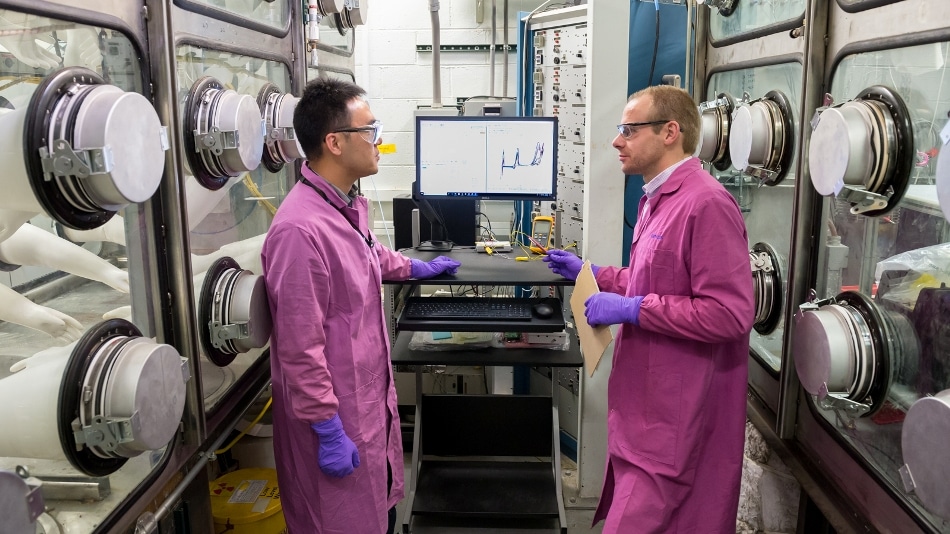Aug 7 2019
Solar power and nuclear power may appear to be extremely different energy sources. Nuclear power originates from the energy discharged when neutrons crash into uranium atoms, splitting them apart. Solar power originates from the sunlight shining down on earth. However, a few solar plants turn that light into heat, which can be utilized in the same manner as the heat of a nuclear reactor to produce steam to create electricity. Also, both energy sources frequently share a core ingredient: salt.
 Jicheng Guo (left) and Nathaniel Hoyt (right) discuss Argonne National Laboratory’s new molten salt sensors that will monitor and remove impurities from the ultra-hot liquid, a promising piece of forthcoming concentrating solar power technology. (Image credit: Argonne National Laboratory)
Jicheng Guo (left) and Nathaniel Hoyt (right) discuss Argonne National Laboratory’s new molten salt sensors that will monitor and remove impurities from the ultra-hot liquid, a promising piece of forthcoming concentrating solar power technology. (Image credit: Argonne National Laboratory)
Occasionally, engineers have used molten salt to fuel and cool nuclear reactors. As nuclear fuel, salt is appealing as it endures radiation and can work at near-normal pressure and comparatively low temperatures.
Salt also stays moderately inert and stable within the nuclear fuel cycle. At present, engineers from the U.S. Department of Energy’s (DOE) Argonne and Oak Ridge national laboratories are relying on several years of nuclear research on salts to progress a solar technology known as concentrating solar-thermal power (CSP).
Turning up the heat
CSP works when mirrors reflect and focus sunlight onto a receiver, which traps the light, changing it into heat stored in a hot fluid. Akin to power sources, such as fossil and nuclear fuels, that heat turns turbines, producing electricity.
Researchers are aiming to make CSP more efficient and economical than competitor technologies. Commercial CSP power plants, such as the revolutionary U.S. Crescent Dunes Solar Energy Project, produce and store electricity by heating molten or liquid nitrate salts to 565 °C. But that temperature limits the efficiency of the system and makes it hard for decreasing production costs.
Of late, researchers are looking at chloride salts, which can be heated up to 750 °C. At higher temperatures, CSP may deliver sufficiently high efficiencies to reach the target cost range—5 to 10 cents per kilowatt-hour, as opposed to 10.3 to 18.4 cents per kilowatt-hour today—of DOE’s Solar Energy Technologies Office (SETO) within the Office of Energy Efficiency and Renewable Energy.
To realize this goal, SETO is financing research at Argonne and Oak Ridge, as well as many other national laboratories and universities.
The most efficient CSP systems take advantage of a large temperature difference between the hot leg (the pipe section containing the highest-temperature fluids) and the cold leg (the pipe section that carries salt from the turbines after its heat has been transferred). That big difference in temperature lets you generate a lot more electricity.
James Willit, Principal Chemist, Chemical and Fuel Cycle Technologies Division, Argonne
Keeping it clean
Regardless of its promise, high-temperature molten salt has the tendency to corrode a number of materials. “You need to control what’s going on in the salt to avoid corrosion and equipment failure,” said Nathaniel Hoyt, a chemical engineer at Argonne. He and Argonne team members Mark Williamson, director of the Chemical and Fuel Cycle Technologies division, and Jicheng Guo, a postdoctoral researcher, are trying to find a solution.
In 2018, the team joined a group of scientists from Oak Ridge, Virginia Tech, and the University of Utah who are designing a CSP prototype for high-temperature molten salt to test the concept’s performance. The role of Argonne is two-fold:
- Design sensors that can monitor the salt composition as it flows through the hot and cold legs of a looped pipe
- Get rid of salt impurities, such as hydroxychlorides and oxides that trigger corrosion
Argonne’s sensors compute electrochemical responses in the salt, evaluating its health, and detecting possible issues. When salt is exposed to water, for instance, hydrochloric acid is created in it, which can corrode the CSP system’s metal pipes. This corrosion leads to the presence of iron, chromium, and other structural metal ions in the salt, which can reduce the system’s long life.
Once the sensors spot impurities, the system automatically switches on a separate electrolysis system, which incorporates magnesium to the salt to eliminate the corrosive elements.
We actively maintain the salt impurities in a range where corrosion won’t happen.
Nathaniel Hoyt, Chemical Engineer, Argonne
The amazing race
The technology is established on Argonne’s founding mission of investigating peaceful uses of nuclear energy. Several years of work with high-temperature molten salts have resulted in significant progress in reactor designs and pyroprocessing, a technique of recovering and reusing nuclear fuel that was established at the laboratory, stated Williamson.
The research is also part of a larger, five-year program sponsored by SETO, called Gen3 CSP, to discover the best approach to next-generation high-temperature CSP systems. Rather than heating molten salt, for instance, why not heat gases such as carbon dioxide, and solids, like ceramic or sand particles? Researchers at other universities and national laboratories are involved in their own projects to find answers.
The race has just begun and hence it is very early to pick front-runners. The subsequent steps for researchers at Argonne and Oak Ridge are to fit the prototype’s key components, run it successfully, and complete preliminary testing.
If SETO chooses Argonne and Oak Ridge’s method in 2021, the researchers will construct their CSP system at a much larger scale, showcasing both laboratories’ versatility in adapting well-established technology from one industry to another.
DOE’s Office of Nuclear Energy finances Argonne’s research into molten salts for nuclear applications.
Lowering the Costs of Concentrating Solar Power
Concentrating solar power uses the sun’s rays to create thermal energy that is used to produce electricity, then store it for use when it is needed. (Video courtesy of the U.S. Department of Energy)